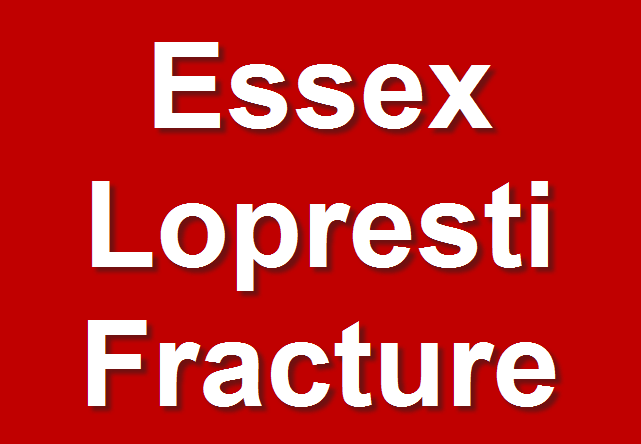Last Updated on October 29, 2023
The Essex Lopresti fracture is also called longitudinal radioulnar dissociation and consists of fracture of the radial head, rupture of the interosseous membrane, and disruption of the distal radioulnar joint. It is important to recognize and have high index of suspicion because Essex Lopresti fracture is often missed.
Isolated radial head fracture can be successfully treated by radial head excision. If Essex Lopresti fracture is missed for isolated radial head fracture, and radial head is excised, it would result in proximal migration of radius and patient may develop severe wrist pain from radial migration and subluxation. In addition, there could be loss of pronation, supination, and extension of forearm. The problem is best dealt at the time of acute presentation. Late reconstruction( > 4 weeks) yields poor results.
Some authors believe that disruption of the triangular fibrocartilage complex is another part of Essex Lopresti fracture.
Relevant Anatomy
Read anatomy of radius
Read anatomy of ulna
The interosseous membrane or interosseous ligament is a quadrangular sheath that extends from the radius to the ulna, linking them together.
It separates the anterior and the posterior compartments of the forearm. Proximally and distally, the membrane is not continuous and is perforated by the posterior and anterior interosseous vessels. Membrane functions to
- Transfer from the radius to the ulna
- Origin of several flexor and extensor muscles – flexor digitorum profundus, flexor pollicis longus, extensor pollicis brevis, abductor pollicis longus, extensor indicis and extensor pollicis longus
- Maintenance of longitudinal and transverse forearm stability
- Provide support during pronation and supination
Relevant Biomechanics
Normally the proximal migration of the radius is kept in check by various restraints. The primary stabilization is by that of the radius head abutting the capitellum. Triangular fibrocartilage complex and interosseous membrane are secondary stabilizers.
An Essex Lopresti fracture is usually sustained during a high energy axial load on an outstretched hand transmitting force through the wrist to the radial head. With radius head fractures, the interosseous membrane rupture and distal radio ulnar joint injury, the radius migrates proximally producing complex forearm instability.
It has been found in cadeveric studies that Essex Lopresti fracture occur when arm is loaded in pronation. Loading in supination and neutral position leads to both bone forearm fracture and isolated radial head fractures respectively.
2-3 mm proximal migration of the radius usually occurs after fracture or excision of the radial head, but it is rarely symptomatic. When both the primary and secondary stabilizers of the forearm are disrupted as in Essex Lopresti fracture, more than 7 mm migration occurs and produces symptom.
As radius migrates proximally, distal ulna becomes dorsally positioned in relation to the carpus resulting in limitation of supination and wrist extension. Proximal migration of the radius also leads to elow pain and limitation of elbow motion.
Clinical presentation of Essex Lopresti Fracture
There is history of significant injury. Patients complain of elbow and wrist pain. Some may also complain of pain throughout the arm. There is tenderness of the wrist especially on the ulnar side. Pain increases on rotation of forearm.
Interosseous space may be tender. Elbow is tender on lateral aspect and may show bruises. An Essex Lopresti fracture is often missed because though fracture of radial head is apparent, injury to the interosseous membrane and triangular fibrocartilage may not be symptomatic. High index of suspicion should be there if there is significant trauma to forearm.
Lab Studies
Not required for diagnosis. These are needed as part of preparation for surgery.
Imaging
Radiographs of the elbow, forearm, and wrist should be obtained to look at the complete forearm for injury. Contralateral wrist x-ray for comparison of ulnar variance may be done.
X-ray of elbow often shows a radial head or neck fracture with or without dislocation at the radiocapitellar joint.
Lateral view of pronated wrist may show ulna to be dorsally subluxated.
CT of elbow may be helpful in determining comminution of radial head.
Treatment
Treatment of Acute Essex Lopresti Fracture
Acute treatment aims to restore radial head and distal radioulnar joint. Open reduction and internal fixation of radial head is done whenever possible. If radial head is not salvageable, radial head prosthesis is considered.
Silicone prosthesis for the Essex Lopresti fracture should be avoided as the material is unable to withstand the compression forces across the radiocapitellar joint.
Simple excision of the head would result in proximal migration of radius.
Distal radioulnar joint is tackled after fixation of radial head. Full supination of the forearm usually results in reduction of RU joint dislocation.
Pinning of radiolulnar joint may be considered for maintaining the length of radius, reduction of distal radio ulnar joint, and anatomic healing of interosseous membrane.
Forearm length is dependent on preservation or replacement of the radial head and repair of the distal radio-ulnar joint.
Stabilization and repair of these two structures are sufficient to restore longitudinal stability forearm, so that open repair of interosseus membrane is not required.
Following surgery, the upper limb of the patient is immobilized in long posterior splint. Kirschner wires, when used to stabilize the DRUJ are removed at 8 to 10 weeks postoperatively and the patient is allowed full range of motion.
Treatment of Chronic Injuries
Old Essex Lopresti fracture is associated with poorer outcome. The various procedures recommend replacement of radial head and augmentation of interossseous membrane. Conversion of the injured forearm to a one-bone forearm remains a salvage option.
